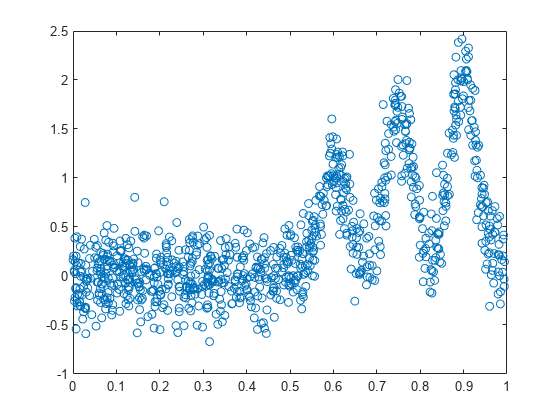混合効果スプライン回帰の近似
この例では、混合効果線形スプライン モデルを当てはめる方法を説明します。
標本データを読み込みます。
load('mespline.mat');このデータは、シミュレーションされたものです。
並べ替えられた に対して をプロットします。
[x_sorted,I] = sort(x,'ascend'); plot(x_sorted,y(I),'o')

次の混合効果線形スプライン回帰モデルを当てはめます。
ここで、 は 番目のノット、 はノットの総数です。 および であると仮定します。
ノットを定義します。
k = linspace(0.05,0.95,100);
計画行列を定義します。
X = [ones(1000,1),x]; Z = zeros(length(x),length(k)); for j = 1:length(k) Z(:,j) = max(X(:,2) - k(j),0); end
変量効果の等方共分散構造によりモデルを当てはめます。
lme = fitlmematrix(X,y,Z,[],'CovariancePattern','Isotropic');
固定効果のみのモデルを当てはめます。
X = [X Z]; lme_fixed = fitlmematrix(X,y,[],[]);
シミュレーションされた尤度比検定を使用して lme_fixed と lme を比較します。
compare(lme,lme_fixed,'NSim',500,'CheckNesting',true)
ans =
Simulated Likelihood Ratio Test: Nsim = 500, Alpha = 0.05
Model DF AIC BIC LogLik LRStat pValue Lower Upper
lme 4 170.62 190.25 -81.309
lme_fixed 103 113.38 618.88 46.309 255.24 0.68064 0.63784 0.72129
値は、固定効果のみのモデルが混合効果スプライン回帰モデルよりも適切でない当てはめであることを示しています。
両方のモデルから近似された値を、元の応答データの上部にプロットします。
R = response(lme); figure(); plot(x_sorted,R(I),'o', 'MarkerFaceColor',[0.8,0.8,0.8],... 'MarkerEdgeColor',[0.8,0.8,0.8],'MarkerSize',4); hold on F = fitted(lme); F_fixed = fitted(lme_fixed); plot(x_sorted,F(I),'b'); plot(x_sorted,F_fixed(I),'r'); legend('data','mixed effects','fixed effects','Location','NorthWest') xlabel('sorted x values'); ylabel('y'); hold off

また、この図からは混合効果モデルの方が固定効果のみのモデルより、データへの当てはめの精度が高くなることもわかります。